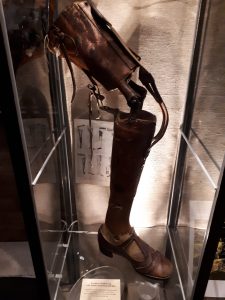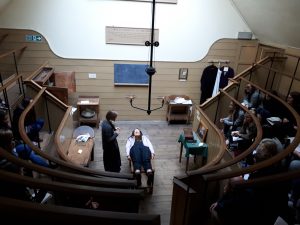Our first stop was the Wellcome Collection where we had the opportunity to visit the library and the museum there. Whilst visiting the library we were given access to a selection of pieces from the Wellcome’s archive. These included medical text books and hand-written lecture notes from students of some of the ‘founding fathers’ of surgery like Joseph Lister. The star piece, however, was a letter from a student surgeon writing home to his father to ask for money, and also to complain of how hard it was becoming for the resurrection men to supply bodies for the student’s anatomical study. Luckily for us, a magnifying glass and transcripts were supplied since the letter showed that doctors’ handwriting had a long history of being awful.
The Wellcome’s museum held several exhibitions all related to medicine and the understanding of our bodies. These exhibitions demonstrated that the Wellcome’s claim to be a space for the ‘incurably curious’ didn’t lie. From a slice of a human body to a skeleton with its pelvis replaced by its skull, one exhibition provided an artistic interpretation of modern medicine. The Wellcome’s real highlight however was the ‘Medicine Man’ exhibition, displaying parts of Henry Wellcome’s collection of curiosities concerning medicine, health and the body. We were half way through our module on the history of surgery and finally the objects allowed us to see the transformation of the rough barber-surgeon to the nineteenth-century refined and professional man of surgery that we had been studying. Rows of amputation saws, forceps and enema syringes suddenly made the pre-anaesthetic operations that we had been reading about feel very close and real. Beyond surgery, the exhibition also satisfied our human fascination for all things weird. Using objects like phallic amulets with horse legs (…really) and male anti-masturbation instruments, the exhibit demonstrated that the need to understand the body from its birth to its death transcends cultures and ages. 
Our day got even stranger when, to get to our next destination, we were led through a tiny door and up flights of a tiny, wooden spiral staircase. In the attic at the top of the stairs we found the Old Operating Theatre. Part museum, part cabinet of curiosities, the Old Operating Theatre was really unique. Then, we were led into what resembled a lecture hall made entirely of wood and filed into rows looking down on to a wooden table. From the gouges in the wood it was clear that this was an operating table and that we were standing in a nineteenth-century operating theatre. It was even more clear that this was the case during the talk we were given on nineteenth century surgery. During the talk our speaker revealed that when the theatre was rediscovered underneath the floorboards workers also found a thick layer of blood-soaked sawdust. When we were told this we quickly volunteered a member of our group -Marissa- to go down to the operating table and help give a demonstration of how an amputation procedure would have been carried out before the introduction of anaesthetic and development of antisepsis. During this talk we also got the chance to handle a few surgical instruments. The lithotomy scoop in particular showed us why it was that patients preferred the fastest surgeons.
 Following the talk we were able to explore the rest of the museum which included collections of surgical equipment, human remains and medicinal herbs giving us an idea of how medicine and illness had been understood in the past. By this time our day was ending and after finding out that the operating theatre and museum were in the attic of the church of the old St. Thomas’ Hospital this suddenly wasn’t a place that you wanted to be left alone in the dark in.
Following the talk we were able to explore the rest of the museum which included collections of surgical equipment, human remains and medicinal herbs giving us an idea of how medicine and illness had been understood in the past. By this time our day was ending and after finding out that the operating theatre and museum were in the attic of the church of the old St. Thomas’ Hospital this suddenly wasn’t a place that you wanted to be left alone in the dark in.

